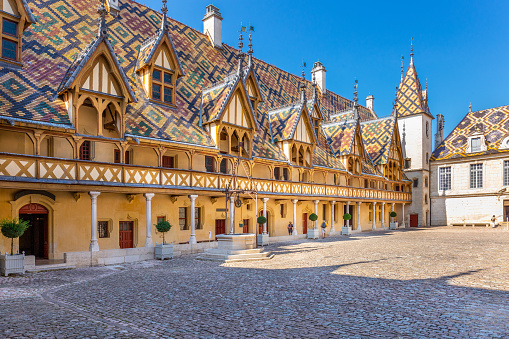"Experience is the name men give to their follies or their sorrows." Alfred de Musset, French romantic dramatist and poet
In episode 13, Marvin Shanken, owner and publisher of the Wine Spectator and I met a little unexpected antagonism in London and then spent a couple of days in Barbaresco and Barolo enjoying northern Italian food accompanied by the wines of Angelo Gaja. Once back in the states, we continued to move the Spectator forward.

Newspaper publishing is non-stop and it doesn't recognize business trips. Take a week off to visit Europe and stories are waiting for you when you return. Such was the case when I got back to my desk, plus I knew we were planning for the first Wine Experience in New York and before then, I had a wine judging.
Unlike today, where it seems like there is a wine competition every other week, in the early 1980s, there was only the Los Angeles County Fair Wine Competition. It was a big event, held over three days at the fairgrounds in Pomona.
The LA competition attracted judges from across the country and occasionally, from Europe. There wasn't anything like it in the United States and European wine people were not yet interested in the concept of wine competitions.
Nathan Chroman, a Los Angeles attorney and part time wine consultant, ran the competition. It was considered an honor to get a phone call from Nathan inviting you to come to Los Angeles to judge wine. As a writer, it was a rare opportunity to taste and learn about hundreds of wines in a controlled setting, without having to buy the wines yourself.
The roster of wine judges then included many recognizable members of the California wine community or folks associated with wine: Robert Lawrence Balzer (Los Angeles Times wine writer), Belle and Barney Rhodes (original owners of Martha's Vineyard in the Napa Valley), Dimitri Tchelistcheff (winemaker son of Beaulieu Vineyard's famous winemaker, Andre Tchelistcheff), Peter Sichel (New York based head of the German wine family), Phil Posson ("father" of California sherry), Bob Thompson (noted wine book author), Darrell Corti (wine buyer for Corti Brothers and noted wine authority), Steve Mirassou (member of the Mirassou wine family), and many others, plus a collection of "friends of Nathan," aka wealthy wine savvy Southern California consumers, including a few members of the so-called "Wine Mafia."
Bleary-eyed and hungry, for at least a cup of coffee, we filed into the tasting room at the fairgrounds in Pomona to face our assignments for the day. Chroman announced the panel assignments and admonished the judges to be fair to the wines. There were four judges to a panel and each judge had a tasting table, surrounded on three sides by curtains. A large can with a couple of inches of saw dust served as the spit bucket.
Every year, Chroman invited a "guest" judge, someone prominent in the wine, food or hospitality industries that would add a little class while, hopefully, drum up publicity for the competition. The wine boom of the seventies was past and newspapers and magazines were cooling to the idea of promoting wine competitions.
In 1979, my second year as a judge at Los Angeles, Chroman invited a young New York restaurateur who just happened to have the hottest restaurant in Manhattan at that time. It turns out the hapless guy didn't know much about about wine and even less about the workings of wine competitions.
About midday, his panel mates were waiting at the caucus table to discuss a flight of wines and they looked over at their missing judge's cubicle and were surprised to see the errant judge with his head on the table and a bone dry spit bucket on the floor beside his chair. No one had told the poor guy to spit not sip so after about six flights of 10 wines each, he was blitzed!
Since this was my second year, I felt a little more at ease, even though I had never goten any feedback on my performance as a judge on Darrell Corti's panel the previous year. Corti always tasted with Phil Posson, the recognized expert in California on fortified wines. On the first morning, I arrived at my panel to see an array of California "dry" Sherries and thought, this must be a test for the new guy.

Corti quickly got introductions out of the way and we adjourned to our tasting cubicles, where I discovered how variable a line of fortified wines can be.
But it was at the caucus table where I learned a lot about how fortified wine is made and in particular what makes a good California Sherry. It was soon clear to me that Spanish Sherry is unique and as pleasant as California Sherry may be, it is not the real thing. And I also found out that I wasn't being tested.
I have judged at Los Angeles for a number of years and noticed that every year one or more odd wines would be entered. Every year, a Southern California winery entered a green mint-flavored wine that became known by the judges as "Scope," since it looked and tasted like the popular mouthwash.
"Scope" was always awarded an Honorable Mention, even though most of the judges did not like it as a wine. Honorable Mention was an award unique to the Los Angeles competition. But by awarding a wine an Honorable Mention, judges could identify the wine, since only the names of winning wines were released.
I could write a book about my experiences as a wine judge, but it's time to move on. In the next episode of "My Life in Wine," I recount the entertaining happens of the first Wine Spectator Wine Experience, held at Windows on the World in New York.
Next Blog: Savoring Soave
Contact me at boydvino707@gmail.net




